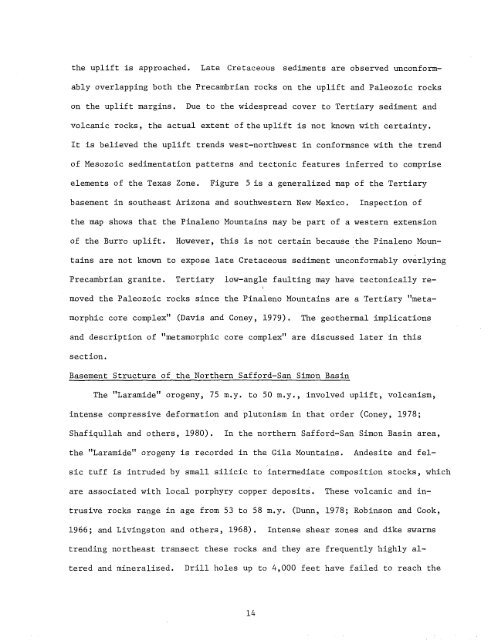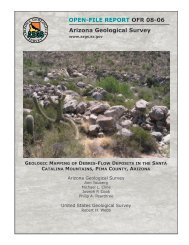geothermal resource potential of the safford-san simon basin, arizona
geothermal resource potential of the safford-san simon basin, arizona
geothermal resource potential of the safford-san simon basin, arizona
You also want an ePaper? Increase the reach of your titles
YUMPU automatically turns print PDFs into web optimized ePapers that Google loves.
<strong>the</strong> uplift is approached. Late Cretaceous sediments are observed unconformably<br />
overlapping both <strong>the</strong> Precambrian rocks on <strong>the</strong> uplift and Paleozoic rocks<br />
on <strong>the</strong> uplift margins.<br />
Due to <strong>the</strong> widespread cover to Tertiary sediment and<br />
volcanic rocks, <strong>the</strong> actual extent <strong>of</strong> <strong>the</strong> uplift is not known with certainty.<br />
It is believed <strong>the</strong> uplift trends west-northwest in conformance with <strong>the</strong> trend<br />
<strong>of</strong> Mesozoic sedimentation patterns and tectonic features inferred to comprise<br />
elements <strong>of</strong> <strong>the</strong> Texas Zone. Figure 5 is a generalized map <strong>of</strong> <strong>the</strong> Tertiary<br />
basement in sou<strong>the</strong>ast Arizona and southwestern New Mexico.<br />
Inspection <strong>of</strong><br />
<strong>the</strong> map shows that <strong>the</strong> Pinaleno Mountains may be part <strong>of</strong> a western extension<br />
<strong>of</strong> <strong>the</strong> Burro uplift. However, this is not certain because <strong>the</strong> Pinaleno Mountains<br />
are not known to expose late Cretaceous sediment unconformably overlying<br />
Precambrian granite. Tertiary low-angle faulting may have tectonically removed<br />
<strong>the</strong> Paleozoic rocks since <strong>the</strong> Pinaleno Mountains are a Tertiary "metamorphic<br />
core complex" (Davis and Coney, 1979). The <strong>geo<strong>the</strong>rmal</strong> implications<br />
and description <strong>of</strong> "metamorphic core complex" are discussed later in this<br />
section.<br />
Basement Structure <strong>of</strong> <strong>the</strong> Nor<strong>the</strong>rn Safford-San Simon Basin<br />
The "Laramide" orogeny, 75 m.y. to 50 m.y., involved uplift, volcanism,<br />
intense compressive deformation and plutonism in that order (Coney, 1978;<br />
Shafiqullah and o<strong>the</strong>rs, 1980).<br />
In <strong>the</strong> nor<strong>the</strong>rn Safford-San Simon Basin area,<br />
<strong>the</strong> "Laramide" orogeny is recorded in <strong>the</strong> Gila Mountains.<br />
Andesite and felsic<br />
tuff is intruded by small silicic to intermediate composition stocks, which<br />
are associated with local porphyry copper deposits.<br />
These volcanic and intrusive<br />
rocks range in age from 53 to 58 m.y.<br />
(Dunn, 1978; Robinson and Cook,<br />
1966; and Livingston and o<strong>the</strong>rs, 1968). Intense shear zones and dike swarms<br />
trending nor<strong>the</strong>ast transect <strong>the</strong>se rocks and <strong>the</strong>y are frequently highly altered<br />
and mineralized.<br />
Drill holes up to 4,000 feet have failed to reach <strong>the</strong><br />
14

















